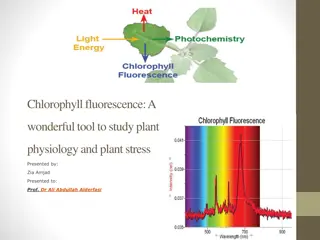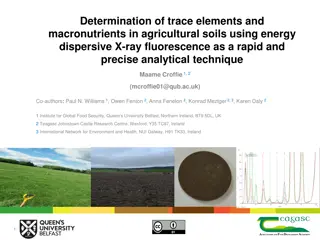Algal Pigments Market: Type, and Application
Meticulous Research\u00ae\u2014a leading global market research company, published a research report titled, \u2018Algal Pigments Market by Type (Beta-Carotene, Astaxanthin, Phycocyanin, Phycoerythrin, Chlorophyll), Form (Powder), Source (Microalgae, Macroalgae), Application (Food & Beverages, Aquac
8 views • 2 slides
Advanced Microscopy Techniques and Applications in Cell Biology
Explore the diverse world of advanced microscopy techniques in cell biology, from confocal and super-resolution imaging to Fluorescence Resonance Energy Transfer (FRET) microscopy and Fluorescence Recovery After Photobleaching. Discover the latest methods, considerations, and applications for studyi
3 views • 21 slides
Projections Show Algal Pigments Market Set to Surpass $669.8 Million by 2030
Dive into the dynamic realm of the algal pigments market with a comprehensive analysis of types, forms, sources, and applications. This forecast encapsulates a wide spectrum of algal pigments including Beta-Carotene, Astaxanthin, Phycocyanin, Phycoerythrin, and Chlorophyll, predominantly in powder f
0 views • 4 slides
Algal Pigments Market Set to Hit $669.8 Million by 2030
Dive into the dynamic realm of the algal pigments market with a comprehensive analysis of types, forms, sources, and applications. This forecast encapsulates a wide spectrum of algal pigments including Beta-Carotene, Astaxanthin, Phycocyanin, Phycoerythrin, and Chlorophyll, predominantly in powder f
0 views • 4 slides
Understanding Fluorimetry: Principles and Applications
Fluorimetry is the measurement of fluorescence intensity at a specific wavelength using instruments like filter fluorimeters. It involves the excitation of molecules by radiation, causing electron promotion and emission of radiation. This process includes states like singlet and triplet, with relaxa
3 views • 45 slides
Understanding Chloroplast: The Green Powerhouse of Plant Cells
Chloroplasts, key organelles in plant cells, contain chlorophyll for photosynthesis, producing food and oxygen. They are absent in animal cells, housing their own DNA and capable of independent reproduction. The structure includes grana and stroma, each serving vital roles in energy production withi
0 views • 11 slides
Understanding Photosynthesis: Process, Importance, and Stages
Photosynthesis is a vital process where plants make their own food using carbon dioxide, water, and light energy. It plays a crucial role in producing oxygen, removing carbon dioxide from the air, and forming fossil fuels. The balanced equation for photosynthesis shows how glucose and oxygen are pro
0 views • 34 slides
Understanding Chloroplasts: Structure, Function, and Marker Enzymes
Chloroplasts are vital organelles in plant cells responsible for photosynthesis, converting light energy into chemical energy. They contain chlorophyll pigments for light absorption and play a crucial role in synthesizing foodstuffs. Marker enzymes such as RUBISCO, NADP-Reductase, and ATP synthase a
1 views • 7 slides
An Overview of Medical Mycology: Fungi and Their Characteristics
Medical mycology, focusing on fungi that infect humans, explores the study of fungi, their morphology, classification, and diseases. Fungi, non-photosynthetic organisms, lack chlorophyll and depend on external organic sources for nutrients. With an eukaryotic nature, fungi exhibit less differentiati
0 views • 68 slides
Understanding Fluorimetry: Principles, Applications, and Instrumentation
Fluorimetry is a technique that measures fluorescence intensity of molecules when excited by radiation. It involves the promotion of electrons from ground to excited states, leading to emission of radiation. This process includes singlet and triplet states, as well as relaxation mechanisms like Coll
0 views • 45 slides
Understanding Fluorescence Analysis in Pharmaceutical Sciences
Fluorescence analysis is a crucial technique in pharmaceutical analysis, involving the emission of radiation by molecules when excited at specific wavelengths. Factors influencing fluorescence, such as concentration, light intensity, adsorption, oxygen presence, pH, temperature, viscosity, and photo
2 views • 26 slides
Understanding Fluorescence Microscopy: Principles and Applications
Fluorescence microscopy, pioneered by British scientist Sir George G. Stokes, reveals hidden details in specimens using fluorescent dyes that emit light of longer wavelengths. This innovative technique allows for visualization of cellular components that are otherwise colorless under conventional mi
0 views • 19 slides
Exploring the Fascinating World of Photophysics and Luminescence
Dive into the intriguing realm of photophysics, where various emission and loss processes lead to luminescence phenomena such as fluorescence, phosphorescence, and chemiluminescence. Discover the beauty of bioluminescence in nature, from fireflies to bioluminescent red tide events. Explore the mecha
0 views • 16 slides
NC22Plex STR Detection Kit: Advanced 5-Color Fluorescence Detection System
Explore the cutting-edge NC22Plex STR Detection Kit from Jiangsu Superbio Biomedical, offering a 5-color fluorescence detection system suitable for multiple applications. Enhance your research capabilities with this innovative product designed for precision and efficiency.
0 views • 20 slides
Understanding the Fascinating World of Fungi: Mycology Insights
Explore the realm of fungi through the lens of mycology, delving into their diverse characteristics, including their eukaryotic nature, heterotrophic lifestyle, and impact on various ecosystems. Discover how fungi play crucial roles as saprophytic, symbiotic, or parasitic organisms, influencing food
0 views • 26 slides
Understanding Photosynthesis and Cycling of Matter in Living Systems
Photosynthesis, the process by which plants convert sunlight into chemical energy, and the cycling of matter through carbon, nitrogen, and water cycles are crucial aspects of living systems. Chloroplasts and chlorophyll play key roles in photosynthesis, while the carbon cycle highlights the essentia
0 views • 20 slides
Exploring Fluorescence Microscopy and High-Speed Cameras in Modern Biology
Delve into the fascinating world of fluorescence microscopy and high-speed cameras in biology through topics such as detectors for microscopy, Nyquist criterion, visualizing hearing in vivo, and temporal resolution insights. Learn about techniques, equipment, and practical considerations in utilizin
1 views • 69 slides
Understanding Photosynthesis: Energy Transformations and Chlorophyll Absorption
In the process of photosynthesis, light energy is converted into chemical energy stored in sugar molecules through multiple energy transformations. Chlorophyll plays a key role in capturing light energy. By separating chlorophyll from leaf tissue and analyzing its absorbance at various wavelengths u
0 views • 13 slides
Unveiling the Magic of Autumn Leaves: A Journey into Leaf Color Transformation
Explore the fascinating process of autumn leaf color change through engaging activities and informative articles. Delve into the factors influencing leaf color, from chlorophyll to anthocyanins, and understand the role of weather in this natural phenomenon. Discover how trees prepare for winter and
0 views • 17 slides
Understanding Chlorophyll Fluorescence in Plant Physiology
Chlorophyll fluorescence is a powerful tool developed in the 1990s for studying plant physiology and stress. It provides insights into photosynthetic processes at different levels, from subcellular to canopy. By measuring chlorophyll fluorescence, researchers can assess the efficiency of photosynthe
0 views • 16 slides
Understanding Photosynthesis: A Comprehensive Overview
Photosynthesis is the fundamental process through which plants produce food in the form of glucose. This intricate process involves the conversion of carbon dioxide and water into glucose using sunlight as the energy source. The key player in photosynthesis is chlorophyll, a green compound found in
0 views • 13 slides
Insights on Biogeochemical Processes and Metal Interactions in Marine Environments
Delve into the intricate relationships between metals, stoichiometry, and biological quotas in marine ecosystems. Explore the impact of metal interactions on biogeochemical provinces, resource supply stoichiometry, and the constraints they impose on marine biota. Uncover how deep chlorophyll maxima,
0 views • 5 slides
Biophysical Feedbacks in the Global Ocean Research Overview
Biophysical feedbacks in the global ocean, including the impact of chlorophyll on solar radiation penetration, SST, and climate variability, are under-studied in climate models. This research assesses the effects of assimilating ocean color data and incorporating sea state in air-sea flux parameteri
0 views • 5 slides
The Iron Cycle and Aquatic Microbiology
Iron plays a crucial role in terrestrial and marine ecosystems, cycling between living organisms and the geosphere. It is a vital nutrient for plants, essential for chlorophyll production, and for animals, needed to create hemoglobin. The marine iron cycle involves phytoplankton and cyanobacteria as
0 views • 19 slides
Nutrient Criteria Development Plan for High Rock Lake Summary Update
Nutrient Criteria Development in North Carolina has evolved through various stages since 2001, with the key milestones being the development of the Nutrient Criteria Implementation Plan in 2004 and the Nutrient Criteria Development Plan in 2014. The plan aims to link nutrient concentrations with the
0 views • 8 slides
Optimised Live/Dead Fluorescence Spectrometry for Antimicrobial Susceptibility Testing
This study focuses on the optimisation of live/dead fluorescence spectrometry for rapid antimicrobial susceptibility testing. The research uses fluorescent dyes to distinguish between live and dead cells, providing a potential method for quick antimicrobial resistance diagnostics. The experiment inv
0 views • 16 slides
Piseco Lake Environmental Data Analysis
This report highlights the environmental characteristics of Piseco Lake, including its physical and chemical data. The lake's water quality, transparency, temperature, dissolved oxygen levels, pH, alkalinity, phosphorous, nitrates, and chlorophyll levels are analyzed. The data shows trends indicatin
0 views • 21 slides
Applications and Importance of X-ray Fluorescence Spectroscopy in Analytical Chemistry
X-ray Fluorescence Spectroscopy (XRF) is a vital analytical technique used for qualitative and quantitative analysis of elements based on their X-ray emission characteristics. Dr. Uma Sharma, a Professor at Vikram University, details various X-ray analytical methods, including X-ray emission, Auger
0 views • 21 slides
Insights into Seamount-Induced Chlorophyll Enhancements and Currents
Study explores the impact of seamounts on chlorophyll concentrations and fisheries catch, as well as the measurement of ocean currents using arrays of current meters. Additionally, the biophysical drivers influencing Seamount-Induced Chlorophyll Enhancements (SICE) are investigated using geophysical
0 views • 4 slides
Understanding Nitrogen Deficiency in Waterlogged Soils
Explore the impact of waterlogged soils on nitrogen deficiency in plants and discover the role of active transport, soil oxygen displacement, and chlorophyll production. Engage students in solving the issue through an interactive activity that integrates their knowledge of plant biology concepts.
0 views • 12 slides
Understanding Light Interactions: Reflection, Absorption, and Fluorescence
Explore the fascinating world of light interactions, where light can be reflected, absorbed, or transmitted based on the nature of the object it encounters. Learn about absorption in different materials, fluorescence, phosphorescence, and the concepts of specular and diffuse reflection.
0 views • 17 slides
Understanding Light Absorption by Chlorophyll in Biology
Explore how chlorophyll absorbs light in photosynthesis, the role of different types of seaweeds, and the use of spectrometers to measure light absorption. Discover the specific light regions absorbed by chlorophyll A and B, as well as adaptations in seaweeds for varying light intensities. Learn abo
0 views • 9 slides
Understanding Photosynthesis: The Process of Energy Conversion in Plants
Photosynthesis is a vital process where plants, algae, and cyanobacteria convert light energy from the sun into chemical energy in the form of glucose. This energy conversion involves the absorption of light by chlorophyll molecules in chloroplasts, leading to the generation of ATP and the formation
0 views • 12 slides
Understanding Photosynthesis in Higher Biology
Photosynthesis is the process by which plants convert light energy into carbohydrates. This revision guide covers the photosynthesis word equation, stages, uses of products, and the role of light and pigments. It explains the absorption of light by leaves and the importance of chlorophyll and access
0 views • 14 slides
Understanding Photosynthesis: The Process and Importance
Photosynthesis is a vital process where plants convert sunlight, water, and carbon dioxide into energy for growth. Plants, algae, and some bacteria carry out photosynthesis, utilizing chlorophyll to produce glucose, the primary source of energy for plants. The sun provides the energy essential for s
0 views • 21 slides
Understanding Leaf Structure and Photosynthesis in Biology
Green plants use photosynthesis to make their own food by converting light energy into starch and oxygen through chlorophyll in the chloroplasts of their cells. Learn about the structure of a leaf and how to test for starch in this informative presentation.
0 views • 6 slides
Understanding Photosynthesis: Role of NADP and Division into Light and Dark Stages
In photosynthesis, NADP plays a crucial role in carrying hydrogen into the dark stage for carbon dioxide reduction. The process is divided into light and dark stages where different components like chlorophyll, chloroplasts, and electron transfer mechanisms are involved. This division ensures effici
0 views • 50 slides
Rapid Analysis of Soil Macronutrients Using Energy Dispersive X-ray Fluorescence
Determination of trace elements and macronutrients in agricultural soils is crucial for crop productivity. This study highlights the advantages, challenges, and objectives of using energy dispersive X-ray fluorescence for rapid and precise analysis. The method requires minimal sample preparation, co
0 views • 10 slides
Assessment of Eutrophication Using Satellite Chlorophyll-a Concentration in the NOWPAP Region
Assessment of eutrophication in the Northwest Pacific region is conducted using satellite-derived chlorophyll-a concentrations. Thresholds for eutrophic and oligotrophic conditions are defined, with a focus on the years 1998 to 2017. The potential enhancement of eutrophication assessment in coastal
0 views • 5 slides
Microscopic Techniques in Cell Biology: Lessons and Labs Overview
Explore the fascinating world of optical microscopy in cellular biology, covering topics such as image formation, contrasting techniques, fluorescence microscopy, live-imaging techniques, and quantitative microscopy. Dive into the principles behind various microscopy techniques and experimental labs
0 views • 7 slides







































